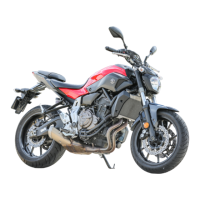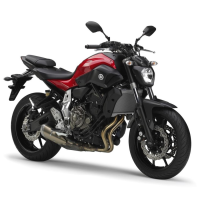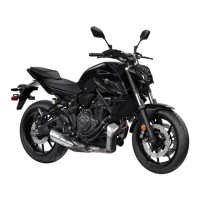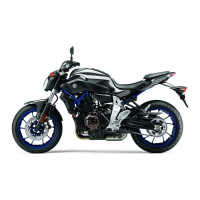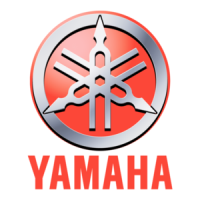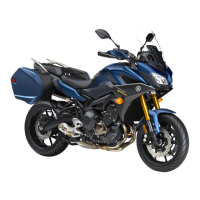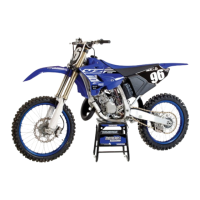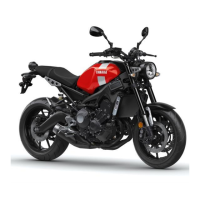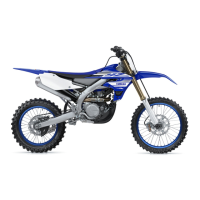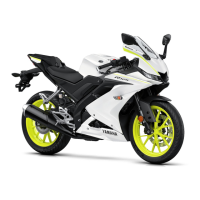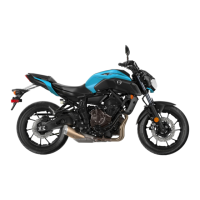
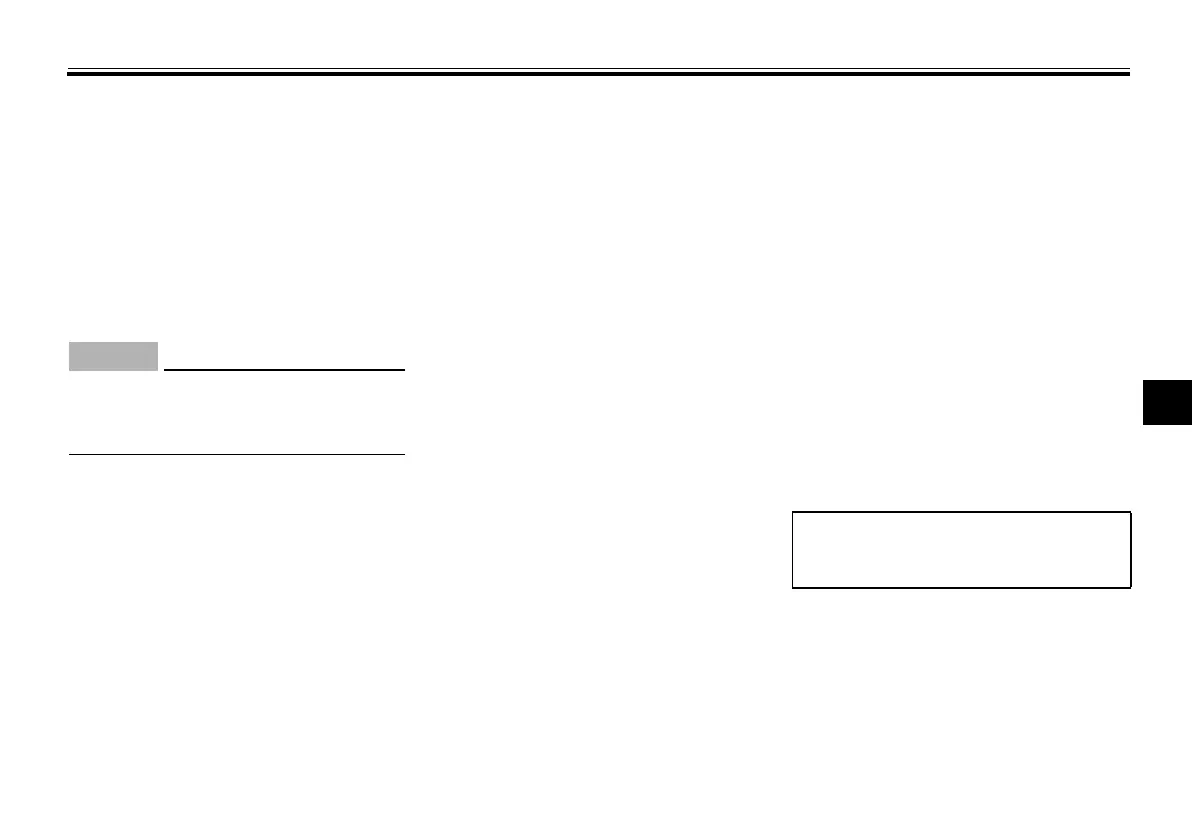 Loading...
Loading...
Do you have a question about the Yamaha MT-07 2019 and is the answer not in the manual?
| Displacement | 689cc |
|---|---|
| Bore x Stroke | 80.0mm x 68.6mm |
| Compression Ratio | 11.5:1 |
| Maximum Power | 55.0 kW (74.8 PS) @ 9, 000 rpm |
| Fuel System | Fuel Injection |
| Ignition System | TCI |
| Transmission | 6-speed |
| Final Drive | Chain |
| Front Suspension | Telescopic forks |
| Front Brake | Hydraulic dual disc, Ø282 mm |
| Rear Brake | Hydraulic single disc, Ø245 mm |
| Front Tire | 120/70 ZR17 M/C(58W) (Tubeless) |
| Rear Tire | 180/55 ZR17 M/C(73W) (Tubeless) |
| Overall Length | 2, 085 mm |
| Overall Width | 745 mm |
| Overall Height | 1, 090 mm |
| Seat Height | 805 mm |
| Wheelbase | 1, 400 mm |
| Wet Weight | 182 kg |
| Fuel Tank Capacity | 14 L |
| Minimum Ground Clearance | 140 mm |
| Oil Tank Capacity | 3.0 L |
| Engine Type | Liquid-cooled, 4-stroke, DOHC, 4-valve |
| Maximum Torque | 68.0 Nm (6.9 kgf-m) @ 6, 500 rpm |
| Rear Suspension | Swingarm, (link suspension) |
Introduces the manual, its purpose, and the benefits of reading it thoroughly.
Explains the meaning of safety symbols, warnings, notices, and tips used in the manual.
Outlines the owner's responsibilities for safe and proper motorcycle operation.
Details essential checks and practices for safe motorcycle operation.
Details essential protective gear for rider safety, including helmet, goggles, and clothing.
Warns about the dangers of carbon monoxide from engine exhaust and how to avoid it.
Provides guidelines for safely loading cargo and accessories, including maximum load limits.
Advises on choosing genuine Yamaha accessories for safety and vehicle compatibility.
Warns about potential safety hazards of aftermarket parts and modifications.
Discusses the importance of using manufacturer-approved tires and rims for performance.
Provides instructions on how to properly and safely transport the motorcycle.
Identifies and labels key components visible from the left side of the motorcycle.
Identifies and labels key components visible from the right side of the motorcycle.
Identifies and labels the various controls and instruments on the motorcycle's handlebars.
Explains the function and operation of the vehicle's immobilizer system for theft prevention.
Details the operation of the main switch and how to lock the steering.
Identifies and explains the function of various indicator and warning lights on the instrument panel.
Provides detailed explanations for specific indicator and warning lights on the instrument panel.
Explains the ABS warning and Immobilizer system indicator lights and their operational meanings.
Describes the multi-function meter unit, its displays, and buttons.
Explains the tachometer, clock, and fuel meter functions of the multi-function display.
Details the Eco indicator, transmission gear display, and multi-function display.
Explains how to switch between different displays on the multi-function meter unit.
Explains how to view and interpret instantaneous and average fuel consumption data.
Details the coolant temperature, air temperature, and brightness control mode displays.
Identifies and explains the function of switches on the left and right handlebars.
Explains the operation and adjustment of the clutch lever, shift pedal, and front brake lever.
Describes the rear brake pedal operation and the Anti-lock Brake System (ABS).
Details how to open and close the fuel tank cap, including safety precautions.
Provides important safety warnings and recommendations for refueling the vehicle.
Discusses recommended fuel types (gasohol) and the function of the fuel tank overflow hose.
Explains the catalytic converter and provides warnings regarding its heat and fuel requirements.
Details the procedure for removing and installing the passenger and rider seats.
Explains how to use the helmet holding cable to secure a helmet to the vehicle.
Identifies the location and use of the storage compartment.
Details how to adjust the spring preload on the rear shock absorber assembly.
Explains how to adjust the rebound damping force of the rear shock absorber.
Describes how to use the luggage strap holders located under the passenger seat.
Informs about the auxiliary DC connector and advises consulting the dealer before installing accessories.
Explains sidestand operation and the function of the ignition circuit cut-off system.
Details the ignition circuit cut-off system and its role in preventing unintended starts or stalls.
Provides a step-by-step procedure to check the proper functioning of the ignition circuit cut-off system.
Details checks for fuel level, lines, and overflow hose to ensure safe operation.
Outlines checks for engine oil level, adding oil, and looking for oil leaks.
Explains how to check coolant level and for leaks in the cooling system.
Details checks for front brake operation, pads, fluid level, and hydraulic system for leaks.
Covers checks for rear brake operation, pads, fluid level, and hydraulic system.
Details checking clutch operation, cable lubrication, and lever free play adjustment.
Explains how to check throttle grip operation and free play, and lubricate the cable.
Covers checking control cables for smooth operation and drive chain slack, condition, and lubrication.
Details checks for wheels, tires, brake/shift pedals, and levers for smooth operation and lubrication.
Explains how to check the sidestand for smooth operation and lubrication.
Covers checking chassis fasteners for tightness and instruments/lights/switches for operation.
Details checking the operation of the sidestand switch for the ignition cut-off system.
Provides instructions on how to start the engine, including pre-start checks and system confirmations.
Explains how to shift gears, including reaching neutral and engaging first gear.
Guides on how to start moving and accelerate smoothly from a stop.
Details how to decelerate smoothly and downshift gears safely.
Offers advice on riding techniques to improve fuel efficiency.
Explains the importance of the engine break-in period and recommended procedures for the first 1600 km.
Provides instructions on how to park the motorcycle safely, including warnings about hot components.
Identifies the tool kit and its purpose for basic maintenance and minor repairs.
Introduces the periodic maintenance charts and provides tips for their use.
Details the maintenance schedule for the emission control system components.
Outlines checks and replacements for the evaporative emission control system.
Provides a comprehensive schedule for general maintenance and lubrication tasks.
Details maintenance for wheel bearings, swingarm pivots, steering bearings, and chassis fasteners.
Covers maintenance for the sidestand, front fork, shock absorber, and rear suspension.
Details engine oil change intervals and cooling system checks and changes.
Outlines maintenance for the throttle grip, cables, lights, signals, and headlight beam adjustment.
Explains how to check, gap, and replace spark plugs, and what they reveal about engine condition.
Details checks for the fuel vapor canister and its breather hose connections.
Guides on checking engine oil level and replacing the oil filter cartridge.
Provides detailed steps for changing the engine oil and replacing the oil filter.
Details the installation of the new oil filter and drain bolt with correct torques.
Explains the advantages and development of Yamalube engine oils.
Guides on checking the coolant level, recommended coolant type, and quantity.
Details the procedure for changing the engine coolant, with safety warnings.
Explains replacing the air filter element and cleaning the air filter check hose.
Details how to measure and adjust the throttle grip free play.
Explains the importance of checking and adjusting valve clearance for engine health.
Guides on checking and adjusting tire air pressure before each ride for safety.
Covers checking tire condition, tread depth, and replacement recommendations.
Lists approved tire sizes, manufacturers, and models for the vehicle.
Details inspection points for wheel rims, including checks for damage and balancing.
Explains how to measure and adjust the clutch lever free play.
Details how to check for and address free play in the front brake lever.
Explains the function of brake light switches and their servicing.
Guides on checking brake pad wear using indicators without disassembling the brake.
Explains how to check the front brake fluid level and replenish if necessary.
Covers checking rear brake fluid level and important precautions for fluid handling and replenishment.
Details the recommended intervals for changing brake fluid and replacing seals and hoses.
Explains how to check and adjust the drive chain slack for optimal performance.
Provides detailed steps for adjusting the drive chain slack, including alignment marks.
Details the proper procedure for cleaning and lubricating the drive chain.
Explains how to check and lubricate control cables for smooth operation.
Guides on checking throttle grip operation and lubricating the throttle cable.
Explains how to check and lubricate the pivots of the brake and shift pedals.
Details how to check and lubricate the pivots of the brake and clutch levers.
Explains how to check and lubricate the sidestand pivot and contact surfaces.
Guides on lubricating the swingarm pivots at specified intervals.
Details how to check the condition and operation of the front fork.
Explains how to check steering bearings for wear or looseness.
Details how to check front and rear wheel bearings for play or smooth rotation.
Covers checking battery connections and general battery information.
Provides instructions on charging and storing the VRLA battery.
Explains how to locate, identify, and replace blown fuses with the correct amperage.
Details the procedure for replacing the headlight bulb, with warnings about handling.
Continues the steps for replacing the headlight bulb and adjusting the beam.
Explains how to replace auxiliary light bulbs if they burn out.
Mentions that the brake/tail light is LED and advises dealer check if it fails.
Details how to replace a burnt-out turn signal light bulb.
Explains the procedure for replacing the license plate light bulb.
Advises on using maintenance stands for stability during service.
Introduces troubleshooting charts and emphasizes seeking dealer assistance for complex issues.
Provides flowcharts to diagnose common starting issues and poor engine performance.
Offers a flowchart to diagnose engine overheating issues and coolant level checks.
Provides specific advice for cleaning and caring for matte-finished parts.
Details recommended procedures for washing, cleaning, and polishing the motorcycle.
Outlines steps for washing the motorcycle, including precautions for water pressure and detergents.
Details drying, lubrication, polishing, and applying protective sprays after washing.
Provides recommendations for storing the vehicle in a cool, dry place and using fuel stabilizers.
Outlines detailed steps for preparing the vehicle for long-term storage, including engine and battery care.
Lists the overall dimensions, wheelbase, ground clearance, and curb weight of the motorcycle.
Provides details on the engine cycle, cooling, valve train, displacement, and drivetrain gear ratios.
Lists specifications for brakes, suspension, electrical system, battery, and lighting.
Explains where to find and record vehicle identification and engine serial numbers.
Identifies the location of the diagnostic connector for service.
Explains vehicle data storage by the ECU and the privacy policy.
Outlines Yamaha's policy on disclosing vehicle data to third parties.
